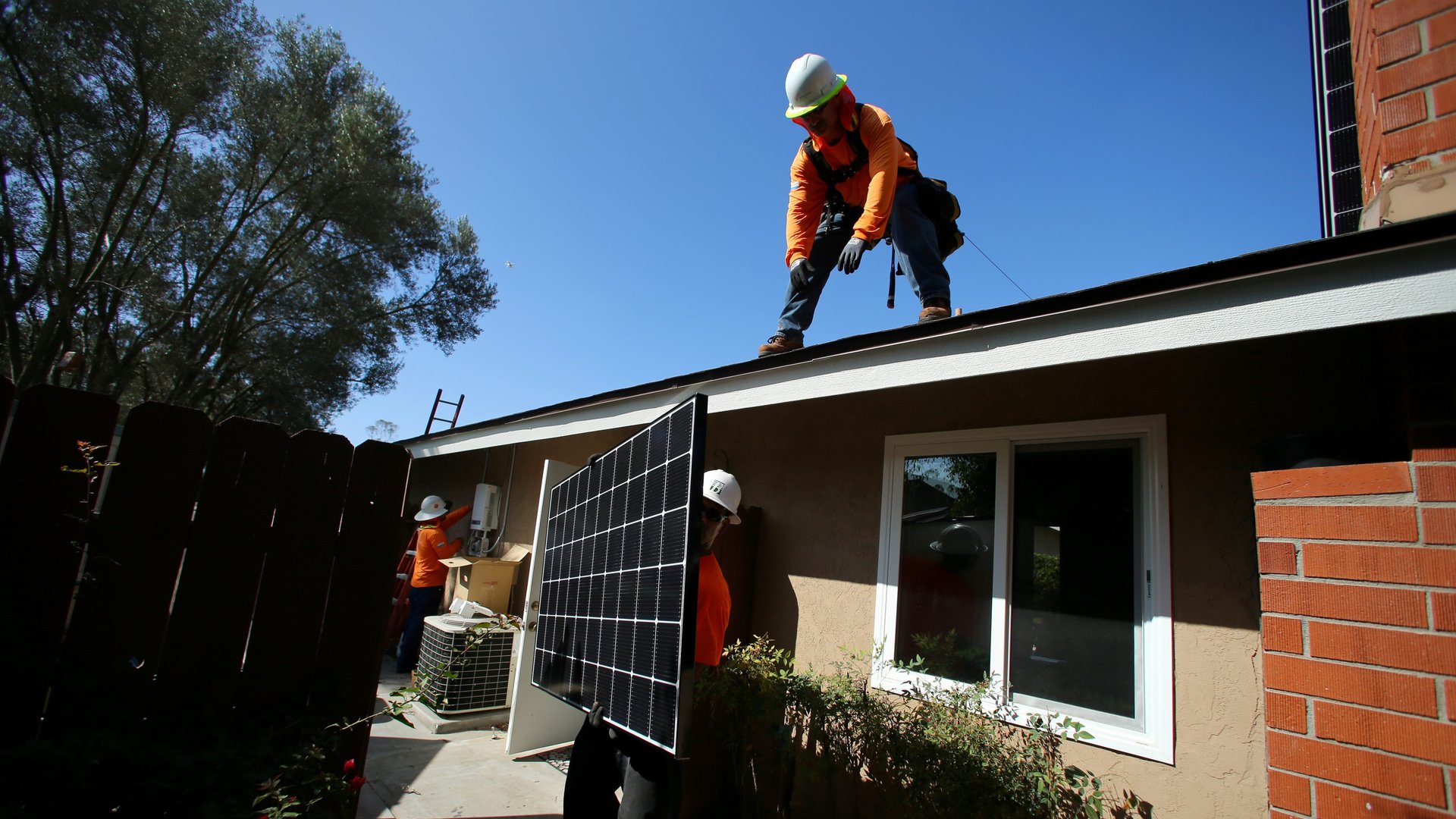The story behind Biden’s plan to create climate jobs that pay “good union wages”
Climate change was on the menu in Joe Biden’s town hall event on Thursday night. He parried an accusation that he wants to ban fracking and got specific about clean energy solutions he wants to see, including carbon capture, better electricity transmission infrastructure, and ending subsidies for fossil fuels.


Climate change was on the menu in Joe Biden’s town hall event on Thursday night. He parried an accusation that he wants to ban fracking and got specific about clean energy solutions he wants to see, including carbon capture, better electricity transmission infrastructure, and ending subsidies for fossil fuels.
“The future rests in renewable energy,” he said. And as he often has, he focused his statement on jobs—specifically jobs that pay “good union wages.”
It was a passing nod to a key problem with how the energy transition is currently playing out: Not all clean energy jobs are, in fact, very good. It’s easy to be seduced by the vision of a coal miner or gas-fired power plant operator laying down their fossil fuel arms and climbing up onto a roof to install solar panels. The reality is messier.
“Particularly in power generation, the workforce is older. When you’re 55, you shouldn’t have to climb a wind tower,” said Jim Harrison, director of renewable energy at the Utility Workers Union of America (UWUA).
That’s not the only issue. Jobs in the fossil fuel industry may have an unsavory carbon footprint, and are highly vulnerable to market fluctuations, but they tend to be well-paying and come with good benefits—especially compared to clean energy. A worker on an oil rig can earn around $180,000; wind turbine technicians start under $55,000.
“Not enough of the new jobs that have been created in the clean energy economy are high-quality, family-sustaining jobs,” said Jason Walsh, executive director of the BlueGreen Alliance, a labor advocacy group whose members include the Sierra Club and Natural Resources Defense Council as well as United Steelworkers and UWUA. “We see problems with wages and benefits.”
One reason is low rates of unionization. Among workers in fossil-burning power plants, union participation runs around 20%, Harrison said. It’s about the same in other fossil fuel production jobs. But in the wind and solar industries, it’s only between 4-6%. That’s about on par with the national average, but low enough to take a meaningful bite out of the kinds of benefits—not only salary, pension, and health-related, but also apprenticeship programs, dispute arbitration, and a clearly established career ladder—that many fossil workers are accustomed to. Some clean energy companies have even been hostile to labor rights. Elon Musk has come under fire for anti-union tweets and allegations of unsafe labor practices at Tesla factories that a union would normally intervene over; Tesla remains without a union. And last year, New York solar installer Bright Power sacked its construction crew after they voted to organize.
Moreover, in some cases, the types of highly-skilled jobs in clean energy that might pay better than the more construction-esque installation jobs—assembling solar and wind electrical components, for example—are still performed offshore, mostly in Asia.
Harrison said that until recently, these concerns were not taken seriously enough by climate hawks in the US.
“This has been an incredibly uneasy transformation,” he said. “Unlike in Europe where the energy transition is kind of managed and there are some social safety nets, this country is undergoing a transition that is not managed other than the market. That has left many of our members behind.”
As a result, a rift has formed between some labor groups and environmentalists. The AFL-CIO, unlike some of its peers, has pointedly not endorsed the Green New Deal championed by liberal Democrats in Congress. And some labor leaders in California and elsewhere have joined oil and gas companies among the most vocal opponents of new climate legislation.
But the tide is turning. The BlueGreen Alliance endorsed Biden, and UWUA is collaborating with the offshore wind developer Orsted on a workforce training center in Long Island. Biden himself has embraced the attitude that supporting workers’ rights to organize and demand better conditions, across all industries, is itself an important form of climate action, Walsh said. And compared to the Obama era, policymakers are beginning to understand that “clean energy jobs” means a hell of a lot more than solar and wind: It’s auto mechanics, architects, electricians, public transit operators, and more.
As president, Biden would have a number of means at his disposal to enforce better labor standards in the industry, said Carol Zabin, a labor economist who directs the Green Economy Program at the University of California, Berkeley. His administration could make sure individual workers aren’t expected to cover the costs of environmental initiatives; long-haul truck drivers, for example, are typically treated as independent contractors and expected to pay for efficiency upgrades on their trucks. It could support union-led apprenticeship programs to, for example, train contractors on how to properly install high-efficiency lighting systems. And it could ensure that any federal climate program or regulation—like renewable energy standards for power companies, fuel efficiency standards, or coastal infrastructure upgrades—include language that sets high labor standards and protects unionization.
“Dealing with climate change is a big policy intervention, and therefore the government has a lot of influence over the type of jobs that are created, the types of opportunities that develop, and the types of employers who get chosen,” she said. ”It’s not about throwing money at green jobs training and saying, ‘Problem solved.’ It’s about a commitment to bring labor along, help unions see their future, and not just feel like they’re going to get screwed.”